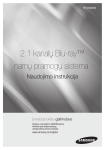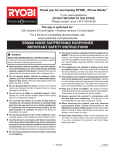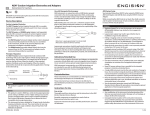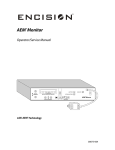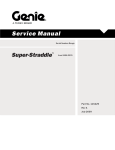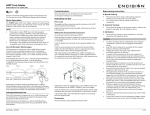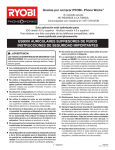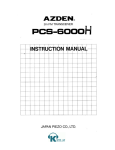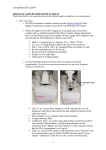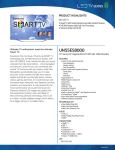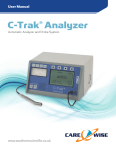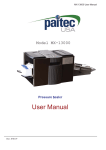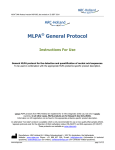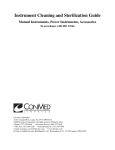Download enTouch™ AEM® Handle Assembly
Transcript
AEM® Handle Assembly EN Instructions For Use/Care ENCISION recommends placing this document in the Instructions for Use/Care Section of your AEM Monitor Operator/Service Manual. Device Description Modular Instruments The ES8000, ES8000L, ES8200 and ES8200L Handle Assemblies are instruments designed for use with reusable and disposable AEM Inserts. Most inserts fit standard 5.5mm trocar cannulas. (Inserts with a larger or smaller cross-section are identified in the catalog description.) The instruments are “true 5mm” and are sized for use with the Disposable Sheath (ES0150A or ES0150-45). Use with Monopolar Electrosurgery AEM instruments, in conjunction with an AEM Monitor properly connected to the electrosurgical generator (ESU), continuously monitor and dynamically manage “stray energy” (insulation failure and capacitive coupling) in zones 2 & 3, which are likely out of the surgeon’s field of view. AEM System Setup See laminated Setup Sheet (00701) when using the ES9005 series AEM Cord Adapter and (02678) when using the ES9015 Universal Adapter. AEM shielding does not cover zone 1, which the surgeon should keep in view during instrument activation. As in all applications, “misapplied” electrosurgical energy remains the responsibility of the attending surgeon. • Laparoscopic surgery may result in gas embolism due to insufflation of gas into the abdomen. • Pulling or tugging cords can result in breaking of internal conductors, causing intermittent alarms or sparking and burning of insulation during use. The AEM Monitor is not designed to detect or prevent an arc in the event of a broken active wire. • Keep electrical connections dry while in use to prevent potential conduction of HF current to the user. • Damaged external insulation AND incorrect setup of the AEM Monitor may result in a risk of unintended patient burn, shock or fire hazard. Do not use product having damaged insulation. Zone 1 Zone 2 Zone 3 Principle of Operation The front and rear handles open and close the working tip (jaw/ blade insert) of the instrument. The working tip of the instrument should always be closed when introducing or removing the instrument from the cannula. Scissors Insert Cord Connection Rotation Knob Shielded Barrel Assembly (Insert Inside) (Note: Zone 1 equals approximately 1.6cm Tip to Shield) (Note: Zone 3 equals area of Trocar Cannula) Laparoscopic procedures should be performed only by surgeons having adequate training and familiarity with laparoscopic techniques and who are also knowledgeable about anatomy and pathology as well as the complications, hazards, risks and benefits of the procedure. Indications/Intended Use Handle Trigger NOTE • This product is rated to 9000 Vp-p. Limit electrosurgical generator power setting to 80 Watts or lower (60 Watts for the Conmed Aspen Excalibur spray mode). Higher settings may result in spurious insulation failure alarms and/or insulation breakdown. See Encision AEM Monitor Operator/Service Manual for list of compatible electrosurgical generators. • See also Instructions for Use/Care for AEM Instruments, Disposable Sheath and Disposable Scissors as applicable. • The ES8000, ES8000L, ES8200, ES8200L handles are not compatible with 35cm or 45cm lengths of the following model number inserts: ES0502, ES0517, ES0518, ES0519, ES0520, ES0529, and ES0545. • Discard on evidence of End of Life Indicators. • This product is supplied non-sterile and must be sterilized prior to use. These AEM instruments incorporate the use of AEM technology and are intended for use in delivering monopolar electrosurgical energy during laparoscopic procedures only. AEM instruments are intended for use with the AEM Monitoring System and electrosurgical generators having compatibility with the AEM Monitor. Scissors Inserts are intended for use on soft tissue only. Contraindications These instruments are not intended for use when laparoscopic electrosurgical techniques are contraindicated. Instructions For Use Warning CAUTION • Good operating room practice suggests that connections of accessories to electrosurgical generators be made only while the generator is Off or on Standby. • Use these instruments only in conditions that assure adequate visualization to minimize risk of misapplied electrosurgical energy. • Keep ESU power setting as low as possible for the intended purpose to minimize unintended burns. • Damaged internal insulation of the cord and/or instrument, or loss of shield continuity, may cause ESU return pad alarms triggered by the AEM Monitor’s Fault Indicators. For maximum patient safety, discontinue use of the instrument if this occurs. • A singular AEM instrument must be the sole conductor of energy to tissue. Do not conduct energy by touching an AEM instrument to a second instrument contacting tissue. The second device will not be protected from capacitive coupling and insulation failure. • Keep electrosurgical instruments away from the patient and operative field when not in use. Accidental activation can result in unintended injury to the patient. • See electrosurgical generator manual and AEM Monitor Operator/Service Manual for precautions concerning the general application of electrosurgical equipment. Prior to Use Thoroughly read these instructions and the instructions in the AEM Monitor Operator/Service Manual. Reusable components are supplied non-sterile. Refer to Reprocessing Instructions prior to use. Disposable inserts and sheaths are supplied sterile. Inspect the instrument for proper assembly and function. See End of Life Indicators. 00209-018 2011/08 1 of 4 EN Assembly Instructions (Handle and Insert) Assemble the two (2) basic components. 1. Hold the instrument upside down as shown. Slide the insert (A) into the handle shaft until the trigger catches and rotates slightly upward. A Reprocessing Instructions 4 Immerse all components in MANU-KLENZ® or equivalent detergent solution (prepared per manufacturer’s instructions) and clean all surfaces. 5 Using a hand held soft bristle brush, use a back and forth motion and brush all surfaces with particular attention paid to Cord Connector, crevices, grooves, fittings, and joints. 6 Hold the instrument as shown below with trigger ends touching. Using a long-handled soft bristle brush with a gauge slightly larger than the lumen of the instrument (recommended size 8Fr/2.7mm), brush the inner lumen of the rear part of the handle using complete strokes while immersed. Push the brush all the way through the lumen and pull it through several times. 7 If necessary, repeat the process on the other end of the lumen as shown below. 8 Flush lumen at end using appropriate sized syringe tubing. 9 Remove the device from the detergent solution and rinse thoroughly under running distilled or demineralized water (minimum of 3 minutes). After use, the instrument must be disassembled, cleaned, lubricated and sterilized before reuse. This product has been validated for 10-6 sterility assurance level when reprocessed in accordance with these cleaning and sterilization instructions. Caution DO NOT FORCE TRIGGER UP - IT WILL ROTATE AUTOMATICALLY AS INSERT ENGAGES. 2. Rotate the insert tip clockwise to screw in the insert. DO NOT USE OPEN BLADES TO TIGHTEN SCISSORS 3. Turn the rotation knob to adjust the positioning of the insert. • Treat a used instrument as a potential biohazard until cleaning and sterilization has been completed. Microscopic residues may remain after cleaning. • Stainless Steel is rust-resistant, not rust-proof. Instruments should be kept dry when not in use. • Do not use bleach (sodium hypochlorite) based products during cleaning. Bleach is extremely corrosive to metals and can negatively affect the electrosurgical instruments. Refer to your cleaning products Material Safety Data Sheet (MSDS) to ensure that they are not corrosive or harmful to various metals (including stainless steel, gold, etc). • Use of some detergent solutions may leave a surfactant residue on the gold connector surface, depending on the strength of the solution and how thoroughly the residues are rinsed off. This may result in intermittent cord alarms. The residue may be removed by use of an alcohol-soaked swab, rotated completely around the external gold connector surfaces. • Certain cleaning chemicals may negatively affect metals, such as the gold connectors. Refer to your cleaning products Material Safety Data Sheet (MSDS) to ensure that they are not corrosive or harmful to various metals (including stainless steel, gold, etc). Cleaning Automated washer/disinfector systems are not recommended as the sole cleaning method for surgical instruments. An automated washer/disinfector system may be used as a follow-up to manual cleaning, but is not required. NOTE • The use of fully distilled or demineralized water is preferred for cleaning and rinsing. Manual Cleaning Step Disassembly/Disposal Disassemble in reverse order from assembly. No further disassembly is recommended. When using a disposable sheath, remove and discard the sheath prior to cleaning. 2 Immerse all components in KLENZYME® or equivalent blood dissolving enzymatic solution (prepared per manufacturer’s instructions) for at least 5 minutes and gently agitate. (Soak longer if proteinaceous material is present.) 3 Remove the device from the enzyme solution and rinse thoroughly under running tap water (minimum of 3 minutes). If using Disposable Sheath, see also Disposable Sheath Instructions For Use/Care. NOTE • Used instruments are considered medical waste. Dispose of in accordance with local regulations. 00209-018 2011/08 Description 1 Combination Manual/Automated Cleaning Step 1 2 3 Description Follow Manual Cleaning steps 1 – 9. Use of a sonicator or ultrasonic cleaner at 35-45 kHz can support manual cleaning of devices. Cycle time 5 minutes maximum. Do not exceed water temperatures above 50°C (122°F). Place instruments in a suitable washer/disinfector basket and process through a standard instrument washer/ disinfector cleaning cycle. See Table listing typical cycles. 2 of 4 AEM® Handle Assembly Instructions For Use/Care EN Typical Automated Washer/Disinfector Cycle for Surgical Instruments Step 1 2 3 4 5 6 7 Description Prewash with cold tap water for 1-10 minutes. Enzyme spray with hot tap water for 1-15 minutes. Rinse with hot or cold water for at least 20 seconds. Detergent wash with hot tap water for 1-20 minutes. Hot water rinse for at least 20 seconds. Thermal rinse (80oC to 98oC / 176°F to 208°F) for 1-5 minutes. Lubricant may be added during this cycle. Hot air dry (use low temperature setting) for 0-10 minutes. NOTE • The washer/disinfector manufacturer’s instructions should be strictly adhered to. Lubrication After cleaning all the components, but before sterilization, lubricate the shaft and all moving parts of the jaw insert with watersoluble medical instrument lubrication. After lubrication, prepare the instrument for sterilization by wrapping in sterile wrap, as appropriate. NOTE • Failure to lubricate may result in increased wear or binding. Sterilization Monitoring sterility using Geobacillus stearothermophilus spore strips is recommended. NOTE • Do not exceed temperatures of 135°C / 275°F. Performance to specification has not been verified above this temperature. Damage to the product may occur. • Validation of sterilization cycles other than steam autoclave is the responsibility of the end user. Step 1 2 3 Description End of Life Indicators Visually inspect and electrically test prior to use. Discontinue use if any of the following are evident: • Intermittent electrical performance • Bent electrode shaft or tip affecting function of sheath or insertion into trocar • Any insulation damage which exposes metal (AEM Shield) along the length of the instrument’s shaft and/or any insulation damage in Zone 1 • Binding or impaired mechanical functions Allow the instrument to dry thoroughly prior to Sterilization. See Caution above regarding removal of detergent solution from the connector surface using an alcohol swab prior to Sterilization. Steam Sterilization – assembled or disassembled: (use one of the methods listed below) Prevac (2 layers of Sterile Wrap or Unwrapped) Express Warranty Temperature: 132°C / 270°F minimum Duration: 4 minutes minimum Gravity Steam (2 layers of Sterile Wrap) See AEM Monitor Operator/Service Manual for details of Limitations, Disclaimer, and Exclusions. Temperature: 132°C / 270°F minimum Duration: 15 minutes minimum. Gravity Steam (FLASH/Unwrapped)* Temperature: 132°C / 270°F minimum Duration: 10 minutes minimum * Flash Sterilization is not recommended, except in emergency situations. CAUTION • Cold Soak Sterilization is not recommended. Testing results indicate that cold soak sterilization (Glutaraldehyde) is not adequate for this product. Manufacturer’s recommended cycle times DO NOT always provide a 10-6 sterility assurance level. • Gas Plasma (Hydrogen Peroxide) Sterilization is not recommended for ENCISION Instruments. Instruments with long, narrow lumens may pose a challenge for this type of sterilization. ENCISION hereby warrants to Buyer that products purchased hereunder shall be free from defects in materials and workmanship under normal use and service, as specified in these Instructions for Use/Care, for the period of six months from date of purchase, or upon reaching an end of life indicator, whichever occurs first. Any evidence of unauthorized modification or repair of this device will void the warranty. Return of Used Product If for any reason this product must be returned to ENCISION, a returned goods authorization is required prior to shipping. Appropriate return instructions may be obtained from ENCISION. Product ENCISION reserves the right to amend, modify or to change any product, to introduce new products, to withdraw products and otherwise vary product specifications at any time without notice. US Patent Nos.: 5,769,841; 6,494,877 ENCISION® and AEM® are registered trademarks of ENCISION Inc. KLENZYME® and MANU-KLENZ® are registered trademarks of Steris Corporation. Product Life The life of this surgical instrument is largely dependent on the care and handling at the point of use / cleaning / sterilization. For optimal instrument life, protect it from contact / impact with other instruments during decontamination and sterilization. The number of uses may be reduced by improper handling, and “prevac” or “flash” sterilization methods. Electrification of scissors inserts may reduce their useful life. 00209-018 2011/08 Federal (USA) law restricts this device to sale by or on the order of a physician. Consult Instructions for Use Latex Free 3 of 4 EN Made in USA Manufactured by ENCISION Inc. 6797 Winchester Circle Boulder, CO 80301 USA Ph: 303-444-2600 Fax: 303-444-2693 Printed in USA © Copyright 2011 Encision Inc. 00209-018 2011/08 4 of 4





